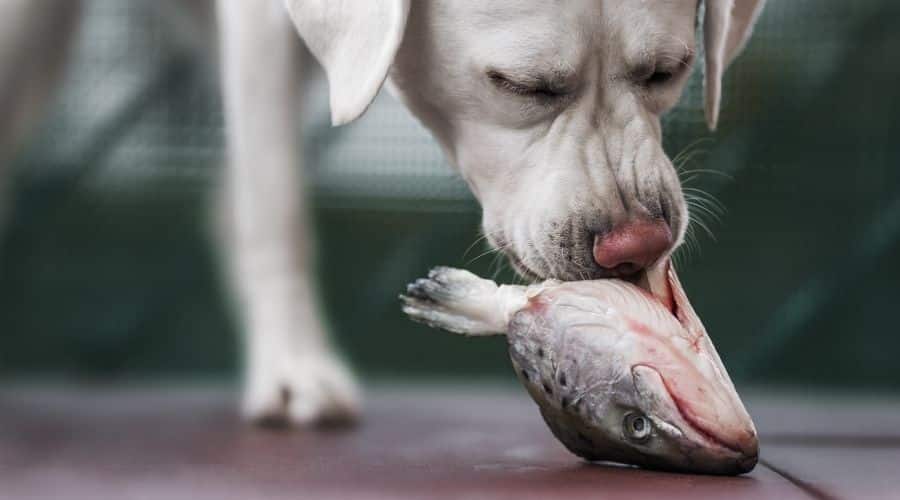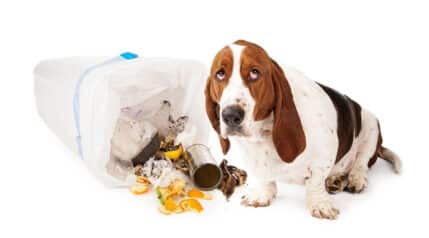Walk down the aisles at the pet store or cast your eye over the list of ingredients in your dog’s food, and you’ll find a myriad of options from fish-flavored foods and fish sticks to fish skins and fresh fish. The endless choices might leave you confused, wondering what is best for your pet.
Dogs are natural carnivores, so they love the tastes and textures of fish, but there are a few things to consider before introducing your dog to any new fishy favorites.
When prepared and fed appropriately, most fish is safe for dogs. Fish can form part of a healthy balanced diet for dogs, either as an occasional snack or as part of their commercially prepared dog food. However, you should be careful with some types of fish. We’ll go over all of this and more to find out how to make sure your dog isn’t in danger when it comes to fishy foods.
Health Benefits Of Fish

Omega 3 gives fish many of its nutritional benefits as it supports the healthy functioning of your dog’s body systems. It’s proven to help the skin’s natural defenses, improve dry skin and dandruff, reduce inflammation, and keep your dog’s coat looking sleek and shiny. So it can be particularly beneficial for dogs with skin problems. Omega 3 also supports your dogs’ immune system, eyes, liver, and kidneys and even contributes to healthy brain development in puppies.
Omega 3 may even have benefits for dogs with heart disease and osteoarthritis. Some studies suggest that omega 3 has antiarrhythmic effects and helps reduce the loss of heart muscle. There is also evidence it may reduce inflammation in joints and help keep dogs active and comfortable. It’s crucial to remember that if your dog has specific health conditions, you must speak to your veterinarian, and any diet changes should only be complimentary to prescribed medication.
Many vets will often recommend fish-based diets for dogs with food allergies or an upset tummy. There is a good reason for this. When cooked, fish is easy to digest, making it a brilliant alternative to meats, such as chicken or beef. The low levels of saturated fats in fish also make it suitable for dogs requiring a low-fat diet after episodes of pancreatitis.
What Types Of Fish Are Safe For Dogs?

Any commercially prepared dog food or treats containing fish is safe, including fish sticks and dried fish skins. Fish fillets (fresh or frozen) are also safe once cooked. Dogs can eat white fish, such as cod or haddock, and oily fish like tuna, whiting, sardines, salmon, and Atlantic mackerel.
What Fish Is Bad For Dogs?

Fish can contain high levels of mercury, heavy metals, and other toxic chemicals that have made their way into rivers and oceans through industrial pollution. When eaten by dogs in large quantities, these toxins can build up, causing long-term health problems. These problems are more prevalent with certain types of fish that are higher in the food chain, like tuna and swordfish.
Fish also has naturally high salt content, and dogs don’t need to eat as much salt as humans. Too much fish can lead to dehydration and other complications.
Are Some Fish Dangerous For Dogs?

Raw fish is bad for dogs. If left uncooked, fish is hard to digest and can contain bacteria and parasites that might make your dog unwell. Cooking eliminates these harmful bacteria.
Raw salmon is particularly dangerous as it can cause salmon poisoning, a potentially fatal condition caused by bacteria. Dogs become unwell within 6-10 days, and symptoms include vomiting, diarrhea, lethargy, depression, dehydration, loss of appetite, fever, weakness, discharge from the eyes or nose, and swollen lymph nodes. With prompt treatment, dogs usually recover in a few days. If your dog has eaten raw salmon, you must contact your vet straight away.
Fish containing bones can also pose a risk to your pet. Fishbones are a choking hazard and can become lodged in the throat. They can also damage the inside of your dog’s mouth or even internal organs. Always ensure you buy deboned fish, or debone it yourself at home.
What Fish Can Dogs Not Eat?

There are also some types of fish that are not good for dogs. You shouldn’t feed your dog any of the following types of fish:
- Raw fish
- Smoked salmon
- Shellfish (as they are filter feeders, shellfish can contain toxins and heavy metals, which could make your dog sick)
- Breaded or battered fish (these contain unhealthy oils and fats that can cause vomiting, diarrhea, and pancreatitis)
- Shark, tilefish, swordfish, and king mackerel
- Fishbones
- Tinned or canned fish in sauce or with added salt
Avoid feeding your dog any fish that is known to be unsafe for them, and always speak to your vet first before making changes to your dog’s diet. You should be especially cautious about giving your dog fish if your dog has a health condition, so talk to your vet if this is a concern.
How Do I Feed Fish To My Dog?

So now we know which fish dogs can and can’t eat, let’s look at how to feed it, how much, and how often.
Remember that fish alone is not suitable for your dog. They need to eat a complete and balanced diet. The safest way to feed a fish-based diet is through balanced commercially prepared dog food. Otherwise, it’s best to keep fish as a special treat – a small amount once or twice a week at the most.
Keeping your dog’s diet varied will keep them interested and excited. If you are feeding fresh fish in addition to your dog’s usual food, then only give it in small portions. Remove a small amount of the everyday food and replace it with fish to minimize the risk of overfeeding. In this case, you should follow the 10% rule: give no more than 10% of your dog’s daily calories in treats each day, including the fish.
If you are buying fresh fish for your dog, ensure you choose from the list of safe varieties and prepare it appropriately (deboned fresh or frozen fish fillets, with no added salt, sauce, or seasoning).
Fish-Based Treats And Snacks

Fish skins are widely available as a dried treat. Although you can prepare them yourself, the ready-made ones are the safest. The crunchiness may help keep a dog’s teeth healthy, and the taste will keep them busy for ages. Fish sticks are another great option, but they can be quite calorific, so they should only be given occasionally.
However, treats aren’t a suitable primary source of nutrition and should be given in moderation. Treats should only make up 10% of a dog’s daily food intake. Too many can lead to obesity and a whole host of health problems. If you aren’t sure exactly how much food your dog needs, your vet will be able to guide you.
Frequently Asked Questions
Is it okay for dogs to have tuna?
Tuna can be high in mercury which can build up in your dog’s body and cause long-term health problems. While moderation is okay, you should not make a regular habit of feeding your dog tuna. But a tablespoon every few weeks is unlikely to harm your dog.
Can dogs eat cod?
Yes, cod is safe for dogs as long as it is unseasoned. It is easy to digest, so it can be especially beneficial to dogs with upset stomachs. Never give your dog battered or breaded cod, though.
Is it okay to feed my dog sardines?
Sardines are oily and rich in omega 3, but as with all fish, they should only be fed occasionally as a tasty treat, not every day. Feeding sardines too often will unbalance your dog’s diet.
How much salmon can a dog have?
You should only feed your dog salmon once a week at the most, and you must cook it because raw salmon can cause salmon poisoning. Feed an appropriate portion for your dog’s weight: up to 10g for every 500g your dog weighs (a 20kg dog can eat 40g of salmon).
Are scallops bad for dogs?
If fed raw, yes, scallops are bad for dogs. But when cooked thoroughly, they can be safe in small amounts.
Can I feed my dog prawns?
No, prawns (and all types of shellfish) are not safe for dogs, especially when raw. They can contain high levels of toxins and heavy metals and are a common cause of food poisoning.
Can dogs die from eating fish?
It is unlikely that eating fish could prove fatal for your dog, but if not prepared properly or if fed in large quantities, it could cause significant health issues. Uncooked fish, shellfish, raw salmon, and fish bones are particularly dangerous for your pet.
Should dogs eat raw or cooked fish?
Dogs should always eat cooked fish without any butter/oil or seasoning. Raw fish can contain bacteria, such as salmonella, as well as parasites, which would be harmful to your dog.
Final Thoughts

It’s safe to feed your dog a piece of fish as an occasional snack, but always seek guidance from your vet on the appropriate amount for your dog according to their age, weight, and health needs. If you’re feeding a complete and balanced dog food containing fish, you should feed it according to the packet guidelines and then adjust depending on how it affects your pet.






This has been very interesting. Learned a lot that I didn’t know and should have. I thank you for the information and will continue with this site to learn more.
Thank you again.